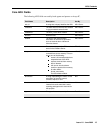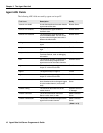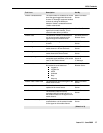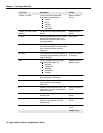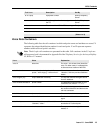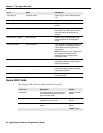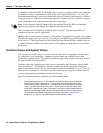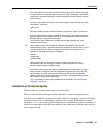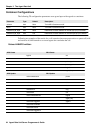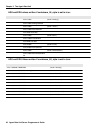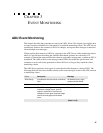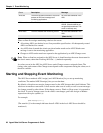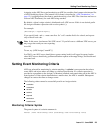
Chapter 2 The Agent Data Unit
22 Agent Data Unit Server Programmer’s Guide
For example, within each ADU, the Telephony Server creates a container called ts, and within the
ts container it creates a subcontainer for each of the agent's logical phones (ts.1, ts.2, and so on).
Each data item pertaining to that logical phone takes a private subtree of the container–ts.1.phone,
ts.1.ptype, and so on. Values for a second logical phone are written in fields ts.2.phone, ts.2.ptype,
and do not interfere with values written for the first logical phone.
Note: For the Northern Telecom Meridian Link, the position ID and the IDN are considered
separate logical phones, even though they share the same physical device.
The ts containers are maintained by Telephony within Avaya IC. You can create additional
containers to suit your specific application.
Methods exist to return an entire container or subcontainer. Using the above example, to see all the
data about the agent's first logical phone, you would use the GetSubTree() method on the ADUID
and ask for “ts.1”. With the exception of the GetSubTree() and DeleteSubTree() methods, there are
no special container methods. Any method that involves getting or setting data can use container-
based names.
Container Names and Special Tokens
You can specify container names or you can allow the ADU Server to generate container names
for you based on your instructions. A number of special tokens are available for use when
constructing container names. These tokens expand into appropriate strings and automate many of
the steps involved in using containers.
Container names have multiple parts (two or more) separated by dots. Each part, called a name
token, is limited to 1–35 alphanumeric characters (underscore is also permitted), with entirely
numeric name tokens reserved for use with the special tokens described below. Up to 31 dots (32
tokens total) are permitted in a container name. Note that processor usage for container names is
low, but is proportional to the number of tokens in the name.
There are four special tokens available for use with container names:
+ The simplest special token is +. This expands into a numeric token that is greater than
the last numeric token created with a + in that position (for that container in that ADU).
The first time it is used, it generates a 1. This means that if any client specifies a name of
“code.+”, the ADU server turns it into “code.1”, but the next time any client uses “code.+”
in that ADU, it expands into code.2. This makes it very easy to create subtrees within a
container. The name generated in this way will never be the name of an existing subtree.
(The gencount and padwidth configuration parameters, described in “Configuration
Parameters,” on page 37), can affect subtrees created with the + token.)




